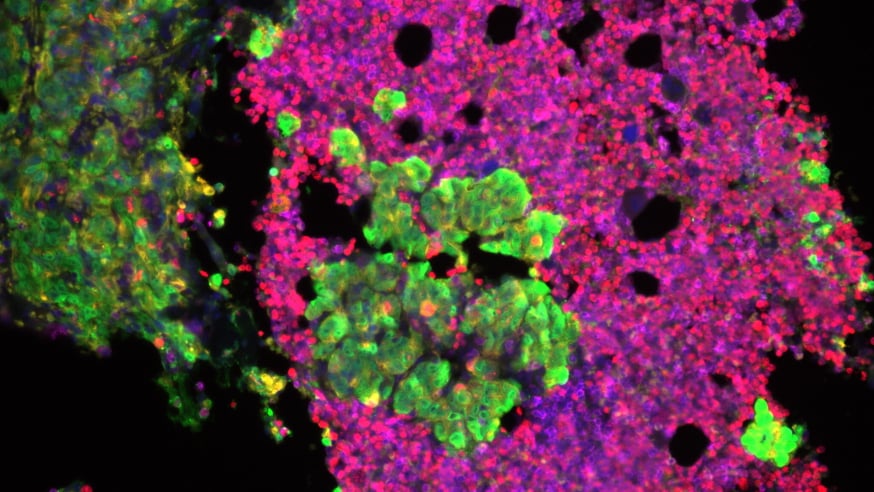
Prostate Cancer Cells (image: Professor Johann de Bono/the ICR)
Back in July, The Institute of Cancer Research, London and The Royal Marsden NHS Foundation Trust launched our new research strategy, and one of its key sections is called ‘Making it count’.
It’s all about how it’s not enough to make scientific discoveries, or even to develop new treatments — we also need to be having a real impact on patients’ lives.
Where we make important discoveries, we want to see these change healthcare practice: extending lives, and improving quality of life, for people with cancer.
One of the last steps of a treatment’s journey to patients is often appraisal by NICE, to establish whether it represents a good use of NHS money. Over the last couple of years I have been following the appraisal of radium-223, a special type of radioactive drug treatment for men whose prostate cancer has spread to their bones.
I was really pleased to see that on Friday 2 September 2016, NICE announced that radium-223 will now be made available on the NHS for a group of men who were previously unable to get it.
Before I go into the details of the decision, I’ll just tell you a bit about the treatment itself, as it uses some pretty interesting science to attack the tumour directly.
Few side-effects
Radium-223 is a radioactive version of the element radium with similar chemical properties to calcium — an important component of our bones.
It tricks the body into taking it up into growing bone, and because cancer cells tend to be growing and dividing more often than healthy tissue, they are disproportionately dosed by radiation.
The radiation given off by radium-223 has a short range so it does very little damage to surrounding tissues like the healthy cells of the bone marrow, causing few side-effects.
The ICR and our partner The Royal Marsden led the key phase III trial which showed that radium-223 gives men with late-stage prostate cancer an average extra 3.6 months of life.
Radium-223 also gives men a much better quality of life as it targets bone metastases, which can cause significant pain. Around 90% of men with advanced prostate cancer have these bone metastases.
Limited access
Since January 2016, radium-223 has been available on the NHS for men in England and Wales after they have had chemotherapy, but NICE did not approve its use in men who hadn’t had or weren’t able to have chemotherapy.
Some men, for example, may be too frail to cope with the side-effects of chemotherapy or might have another illness that means that chemotherapy isn’t suitable for them. It’s estimated that they make up around 50% of all men with advanced prostate cancer, so it’s a pretty large group of men.
After NICE turned radium-223 down, it was made available via the Cancer Drugs Fund for these men who couldn’t or wouldn’t have chemotherapy.
But in April 2016, NICE took over responsibility for the Cancer Drugs Fund, and it now has to reassess all drugs provided through it. No one knew what would happen to these treatments — including radium-223.
So it is great to hear that radium-223 will now be routinely available for these men on the NHS, providing a welcome additional treatment option for advanced prostate cancer.
‘Fantastic news’
The ICR’s Chief Executive, Professor Paul Workman, welcomed the news: “It is fantastic news that NICE has reversed its previous decision on radium-223 so that men who are too frail to be given chemotherapy can now benefit from the treatment on the NHS in England and Wales.
“Today’s announcement brings us in line with Scotland, where radium-223 is already an option for men with advanced prostate cancer that has spread to the bone, and expands the still limited number of treatment options available to patients.
“This is an exciting and innovative example of a smarter, kinder treatment — specifically targeting bone metastasis and prolonging survival, while reducing the pain and discomfort brought about by bone tumours and improving quality of life.”
Although today marks good news for this particular group of men with prostate cancer, I will be following the progress of radium-223 closely as I think there will be more to come for this interesting treatment. Some studies have started trialling radium-223 in other cancers which have spread to the bone like breast cancers, or bone cancers like osteosarcomas.
And for prostate cancer, because its mechanism of action doesn’t overlap with that of other treatments such as abiraterone, it could be used as part of a combination treatment. Abiraterone and radium-223 are currently being trialled together, and I’ll be interested to see the results.
Radium-223 is a treatment that fills an unmet need, so it is great to see it being made available and doing what our research sets out to do — having a real impact on patients.